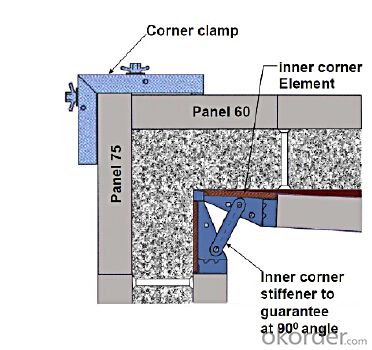Steel-frame Formwork system for corner link
- Loading Port:
- Tianjin
- Payment Terms:
- TT OR LC
- Min Order Qty:
- 50 m²
- Supply Capability:
- 1000 m²/month
OKorder Service Pledge
OKorder Financial Service
You Might Also Like
Steel-frame Formwork SF-140
Characteristics:
◆ Few parts for fast forming.
◆ Max. Concrete pressure: 80KN/m2.
◆ Hot-dip galvanized steel frame.
◆ The thickness of plywood is 18mm & the panel is 14cm.
◆ Compatibility with Hunnebeck Manto system due to similar edge profile.
System Details & Application:
◆ Neat joint and fast assembling with aligning panel clamp.
◆ Flexible panel arrangement and height extension.
◆ The selection of panels.
◆ Kinds of panel connectors.
◆ Corner clamp application.
◆ Length adjustment application.
◆ Height adjustment & aligning strut.
◆ Walkway bracket & platform.



- Q: What are the different types of reinforcement systems used with steel formwork?
- Steel formwork in construction projects commonly employs various types of reinforcement systems to enhance strength and stability. These systems aim to withstand the weight of concrete and other loads. Rebar, or steel bars/rods, represents a prevalent reinforcement system. It is typically positioned horizontally and vertically within the formwork, forming a grid-like structure. This arrangement evenly distributes concrete weight and prevents potential cracks or failures. Wire mesh or welded wire fabric serves as another reinforcement system. It comprises a grid of wires laid over the formwork before concrete pouring. The wire mesh reinforces the concrete, providing added strength and durability. Sometimes, steel formwork incorporates precast concrete elements as reinforcement. Precast beams or columns are placed within the formwork to enhance support and reinforcement. Certain formwork systems utilize post-tensioning techniques for reinforcement. This involves the installation of steel cables or bars within the formwork, applying tension after concrete pouring. This technique heightens the formwork and structure's strength and stability. Ultimately, the selection of a reinforcement system depends on project-specific requirements, such as load capacity, design specifications, and desired durability. By employing appropriate reinforcement systems, steel formwork can achieve greater strength and reliability, ensuring project success and safety.
- Q: How does steel formwork perform in seismic zones?
- Due to its high strength and durability, steel formwork is an excellent choice for seismic zones. The robustness of steel enables it to withstand the intense shaking and vibrations caused by earthquakes, as it has outstanding load-bearing capacity and resistance to bending and shearing forces. During an earthquake, seismic zones experience significant ground movement, which exerts immense pressure on the formwork system. However, steel formwork remains rigid and strong, preventing any significant deformation or damage. This ensures the stability and integrity of the structure both during and after the seismic event. Furthermore, steel formwork provides flexibility in design and construction, allowing for reinforced concrete structures that can better handle seismic loads. Additional reinforcement elements, such as steel bars and mesh, can be incorporated with the use of steel formwork, enhancing overall strength and ductility. This helps dissipate the energy generated by seismic forces and reduces the risk of structural failure. In addition to its performance, steel formwork is also cost-effective and sustainable in seismic zones. It can be easily dismantled and reassembled, making it reusable and facilitating quick repair and reconstruction in the event of earthquake damage. This minimizes downtime and ensures the safety of occupants. In conclusion, steel formwork is a reliable and resilient choice for construction in seismic zones. Its strength, durability, and flexibility make it well-suited to withstand the forces generated by earthquakes, ensuring the safety and stability of structures in these high-risk areas.
- Q: Are there any specific maintenance requirements for steel formwork systems?
- Yes, there are specific maintenance requirements for steel formwork systems. Steel formwork systems are used in construction to create temporary molds or frameworks for pouring concrete. These systems are designed to be durable and long-lasting, but regular maintenance is necessary to ensure their proper functioning and longevity. One important maintenance requirement for steel formwork systems is to regularly clean and remove any debris or concrete residue from the surfaces. This can be done by using a wire brush or high-pressure water jet to remove any hardened concrete or build-up. Cleaning the formwork prevents the accumulation of materials that can affect the quality and appearance of future concrete pours. Additionally, it is crucial to inspect the steel formwork system for any signs of damage or wear. This includes checking for cracks, dents, or rust on the steel components. If any damage is found, it should be repaired promptly to prevent further deterioration and to maintain the structural integrity of the formwork. Another maintenance requirement is to lubricate the moving parts of the steel formwork system. This includes hinges, locks, and adjustable parts that allow for easy assembly and disassembly. Lubrication helps to prevent corrosion, ensures smooth operation, and prolongs the lifespan of the formwork system. Furthermore, regular inspection of the formwork system's alignment and stability is necessary. This ensures that the formwork remains level and securely in place during concrete pouring. Any misalignment or instability should be addressed immediately to prevent accidents or structural issues during construction. Overall, proactive maintenance of steel formwork systems is essential to ensure their proper functioning, durability, and safety. Regular cleaning, inspection, repair, and lubrication are key to maintaining the quality and longevity of these systems, ultimately contributing to successful construction projects.
- Q: Can steel formwork be used for both straight and sloping structures?
- Yes, steel formwork can be used for both straight and sloping structures. Steel formwork is a versatile and flexible construction material that can be customized to fit various shapes and configurations. It can be easily adjusted and secured to create straight walls and columns. Additionally, with the use of specialized accessories and components, steel formwork can also be adapted to create sloping structures such as ramps, inclined walls, and curved surfaces. This flexibility and adaptability make steel formwork a preferred choice for construction projects with varying design requirements.
- Q: Are there any limitations or disadvantages of using steel formwork?
- There exist certain limitations and drawbacks associated with the utilization of steel formwork. One constraint pertains to the cost. Comparatively, steel formwork tends to be more expensive in comparison to alternative formwork types, such as wood or aluminum. Consequently, it may not be a practical choice for projects operating within tight budgetary constraints. Another limitation involves the weight and unwieldiness of steel formwork. Its substantial weight makes transportation and handling challenging, potentially necessitating additional equipment and labor. Moreover, the bulkiness can complicate the storage and stacking of the formwork when not in use. The assembly and disassembly of steel formwork also require skilled labor. Unlike certain formwork types like modular or reusable plastic formwork, steel formwork often necessitates custom-made fittings at the construction site. This can lead to increased labor costs and elongated construction timelines. Additionally, without proper maintenance, steel formwork is susceptible to corrosion. Exposing it to moisture, chemicals, and harsh weather conditions can result in rusting, thereby weakening the formwork over time. Regular inspections and maintenance are indispensable for ensuring the longevity and safety of steel formwork. Lastly, depending on the nature of the construction project, steel formwork may not be suitable. Its rigidity and lack of flexibility make it less adaptable to complex or irregular shapes. Consequently, alternative formwork materials or systems may prove more suitable in such instances. Despite these limitations and disadvantages, steel formwork also presents several advantages, including durability, reusability, and a high load-bearing capacity. Consequently, it is crucial to thoughtfully consider the project's specific requirements prior to making a decision on whether to employ steel formwork.
- Q: What are the different types of connections used in steel formwork construction?
- Steel formwork construction utilizes various types of connections, each serving a specific purpose. 1. Bolted connections, the most commonly used type, involve securing steel formwork components together using bolts, nuts, and washers. This connection provides a strong and rigid joint that is easy to assemble and disassemble. 2. Welded connections fuse steel formwork components together using heat and pressure. They are ideal for permanent structures or situations requiring high strength and rigidity. However, welded connections are time-consuming and require skilled labor. 3. Clamped connections utilize clamps or brackets to hold steel formwork components together. This connection type is suitable for temporary structures or frequent disassembly/reassembly, as it is quick to assemble and disassemble and does not require specialized skills or equipment. 4. Interlocking connections employ specially designed mechanisms, such as tabs, slots, or grooves, to connect steel formwork components. These connections are commonly used in modular formwork systems, where fast and easy assembly is necessary. 5. Adhesive connections involve bonding steel formwork components together using epoxy or other adhesive materials. This connection type provides a seamless and smooth joint, often used for architectural or decorative purposes. Proper surface preparation and curing time are essential for achieving maximum strength. In summary, the choice of connection type in steel formwork construction depends on factors such as desired strength and rigidity, structure type, reusability, and available resources and expertise. It is crucial to select the appropriate connection type to ensure the safety and stability of the formwork system.
- Q: Can steel formwork be used for both slab and beam construction?
- Yes, steel formwork can be used for both slab and beam construction. Steel formwork is a versatile and durable option for constructing both slabs and beams in the construction industry. It provides a strong and rigid framework that can withstand the weight and pressure of concrete being poured into it. Steel formwork can be easily assembled and disassembled, making it suitable for various construction projects. Its strength and stability make it an ideal choice for both slab and beam construction, ensuring that the concrete structures are built to the required specifications and can support the loads they are designed for.
- Q: How does steel formwork contribute to faster construction?
- Steel formwork contributes to faster construction by offering several advantages over traditional wooden formwork. Firstly, steel formwork is highly durable and can withstand multiple uses, resulting in reduced downtime and increased productivity. Additionally, its robustness allows for faster assembly and disassembly, enabling quicker turnaround times between construction projects. The precision and accuracy of steel formwork also ensure consistent and high-quality concrete finishes, reducing the need for additional finishing work. Moreover, steel formwork is highly adaptable and can be easily modified or customized to accommodate various building designs, facilitating faster construction processes. Overall, the use of steel formwork accelerates construction timelines and enhances efficiency, thereby contributing to faster project completion.
- Q: Can steel formwork be used for tunnel construction?
- Yes, steel formwork can be used for tunnel construction. Steel formwork refers to the temporary or permanent molds made from steel that are used to shape and support concrete during the construction process. In tunnel construction, steel formwork is commonly used to create the tunnel lining, which provides structural support and protects the tunnel from external forces. Steel formwork offers several advantages for tunnel construction. Firstly, it is strong and durable, capable of withstanding the pressures and forces exerted on the tunnel structure. This makes it suitable for constructing tunnels in various ground conditions, including soft soils, rock, or even underwater. Secondly, steel formwork can be easily customized to the required shape and size, allowing for flexibility in tunnel design. It can be prefabricated off-site and then assembled on-site, reducing construction time and costs. Additionally, steel formwork is reusable, which further enhances its cost-effectiveness and sustainability. Furthermore, steel formwork provides a smooth and high-quality finish to the tunnel lining, ensuring the structural integrity and longevity of the tunnel. It also allows for the easy installation of other tunnel components, such as electrical conduits, ventilation systems, and drainage pipes. However, it is important to note that the selection of formwork material depends on various factors, including tunnel dimensions, construction method, ground conditions, and project requirements. Other types of formwork materials, such as timber or aluminum, may also be suitable for tunnel construction depending on the specific project needs.
- Q: How does steel formwork handle formwork stripping and reassembly?
- Steel formwork is highly effective in handling formwork stripping and reassembly due to its strength, durability, and versatility. When it comes to formwork stripping, steel formwork systems are designed to allow for easy and efficient removal of the formwork after the concrete has set. The steel panels can be easily detached from the structure, and the formwork components can be disassembled without causing any damage to the formwork system or the concrete structure. Steel formwork also offers quick and effortless reassembly capabilities. The panels can be easily repositioned and locked back into place, ensuring a precise and accurate alignment for the next concrete pour. The interlocking mechanism of steel formwork allows for a tight and secure connection, preventing any movement or displacement during the pouring and curing process. Moreover, steel formwork is known for its reusability. Unlike traditional timber formwork, steel formwork can be used multiple times without compromising its structural integrity. This not only makes it cost-effective but also reduces the environmental impact associated with formwork waste generation. Another advantage of steel formwork is its adaptability to different project requirements. Steel panels can be easily modified or customized to accommodate complex shapes, angles, or curves, providing flexibility in various construction applications. This adaptability ensures that steel formwork can handle the stripping and reassembly process efficiently, regardless of the project's design complexities. In summary, steel formwork is a highly reliable and efficient choice for handling formwork stripping and reassembly. Its strength, durability, reusability, and adaptability make it a preferred option in the construction industry, allowing for seamless and hassle-free formwork operations.
Send your message to us
Steel-frame Formwork system for corner link
- Loading Port:
- Tianjin
- Payment Terms:
- TT OR LC
- Min Order Qty:
- 50 m²
- Supply Capability:
- 1000 m²/month
OKorder Service Pledge
OKorder Financial Service
Similar products
Hot products
Hot Searches
Related keywords


















